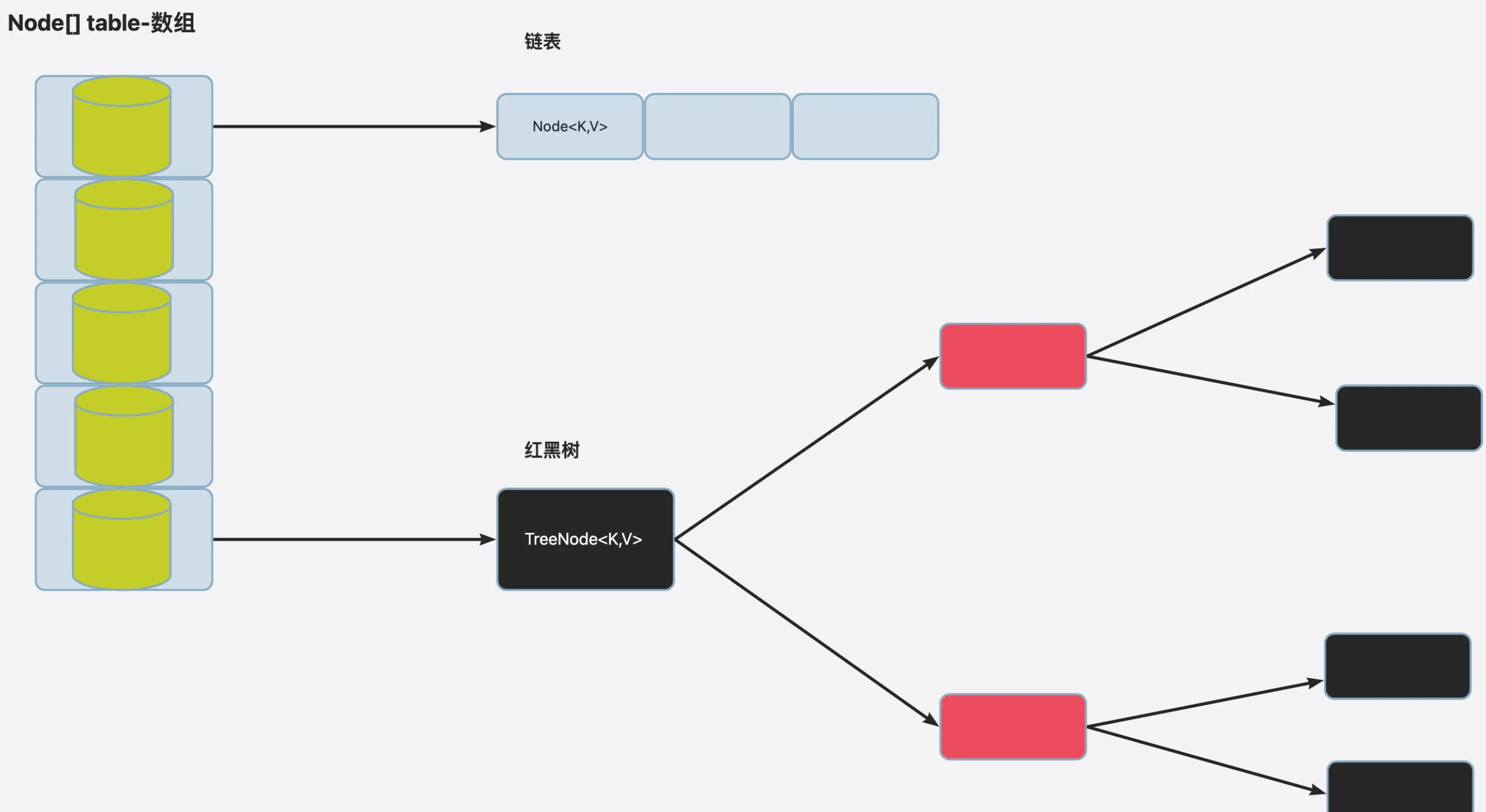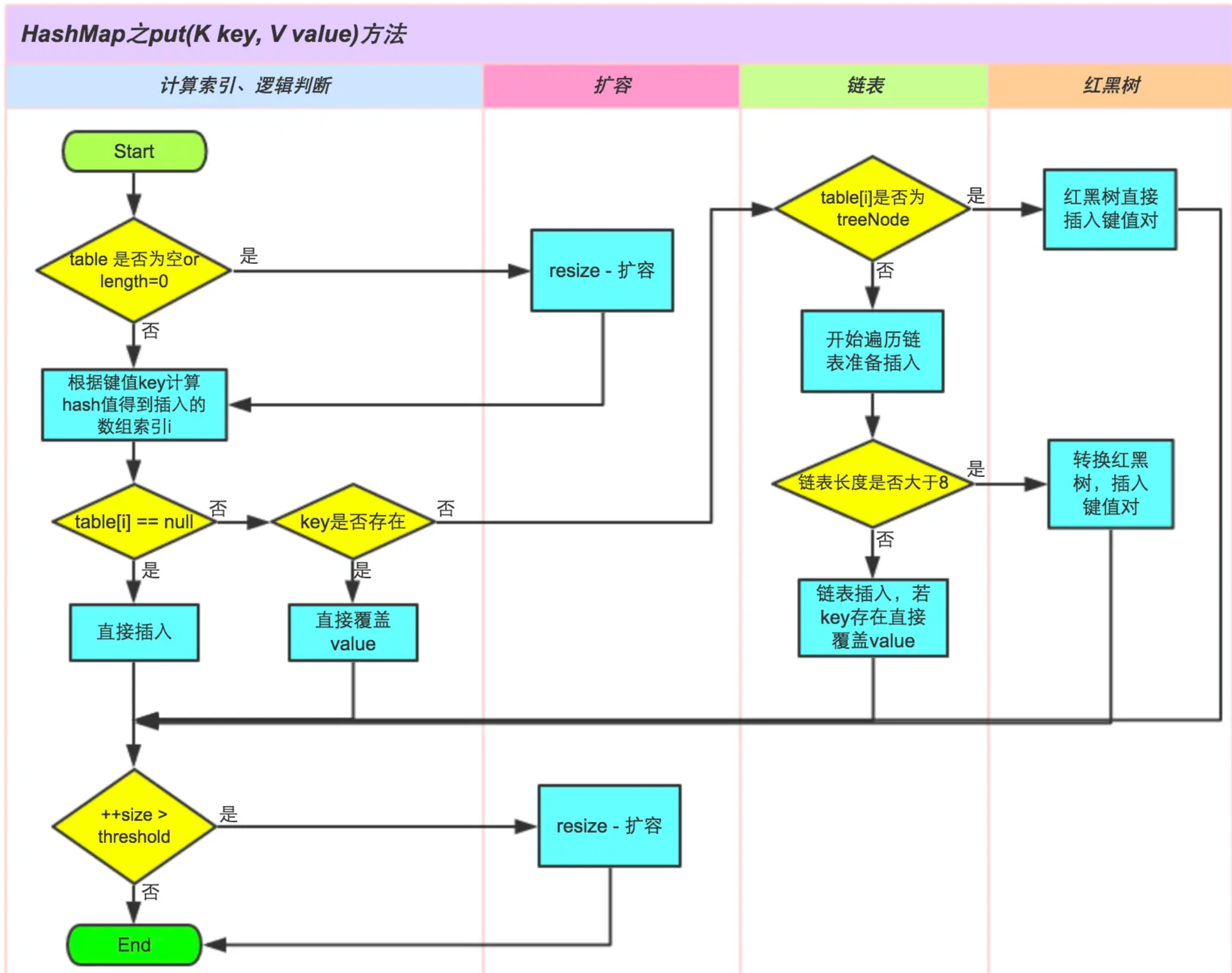文章目录
- HashMap 简介
- 数据结构
- Hash
- 构造方法
- get(key)方法
- 步骤一:通过key获取所在桶的第一个元素是否存在
- 步骤二:该节点的hash和key是否与要查询的hash和key匹配
- 步骤三:当对应桶中不止一个节点时,根据不同节点类型查询
- put(key,value)
- 为什么树化?
- resize-扩容
HashMap 简介
HashMap 主要用来存放键值对,它基于哈希表的 Map 接口实现,是常用的 Java 集合之一,是非线程安全的。
HashMap 可以存储 null 的 key 和 value,但 null 作为键只能有一个,null 作为值可以有多个JDK1.8 之前 HashMap 由 数组+链表 组成的,数组是 HashMap 的主体,链表则是主要为了解决哈希冲突而存在的(“拉链法”解决冲突)。 JDK1.8 以后的 HashMap 在解决哈希冲突时有了较大的变化,当链表长度大于等于阈值(默认为 8)(将链表转换成红黑树前会判断,如果当前数组的长度小于 64,那么会选择先进行数组扩容,而不是转换为红黑树)时,将链表转化为红黑树,以减少搜索时间。
HashMap 默认的初始化大小为 16。之后每次扩充,容量变为原来的 2 倍。并且, HashMap 总是使用 2 的幂作为哈希表的大小。
数据结构
JDK 8版本的HashMap底层数据结构是数组+链表/红黑树结构,具体原因是:
/*** The table, initialized on first use, and resized as* necessary. When allocated, length is always a power of two.* (We also tolerate length zero in some operations to allow* bootstrapping mechanics that are currently not needed.)*/transient Node<K,V>[] table;
这是 HashMap 类中的一个成员变量,它是一个存储桶数组。table 数组用于存储键值对的实际数据。
/*** Basic hash bin node, used for most entries. (See below for* TreeNode subclass, and in LinkedHashMap for its Entry subclass.)*/static class Node<K,V> implements Map.Entry<K,V> {final int hash;final K key;V value;Node<K,V> next;Node(int hash, K key, V value, Node<K,V> next) {this.hash = hash;this.key = key;this.value = value;this.next = next;}
}
这是 HashMap 内部定义的静态嵌套类 Node,它实现了 Map.Entry 接口。每个 Node 对象表示 HashMap 中的一个键值对,它包含键、值以及指向下一个节点的引用。
/*** Entry for Tree bins. Extends LinkedHashMap.Entry (which in turn* extends Node) so can be used as extension of either regular or* linked node.*/
static final class TreeNode<K,V> extends LinkedHashMap.Entry<K,V> {TreeNode<K,V> parent; // red-black tree linksTreeNode<K,V> left;TreeNode<K,V> right;TreeNode<K,V> prev; // needed to unlink next upon deletionboolean red;TreeNode(int hash, K key, V val, Node<K,V> next) {super(hash, key, val, next);}/*** Returns root of tree containing this node.*/final TreeNode<K,V> root() {for (TreeNode<K,V> r = this, p;;) {if ((p = r.parent) == null)return r;r = p;}}}
这是 HashMap 内部定义的静态嵌套类 TreeNode,它是红黑树结构的节点。在 HashMap 中,当链表中的元素数量超过一定阈值时,会将链表转换为红黑树,以提高查找性能。
因此,transient Node<K,V>[] table; 存储了实际的数据,static class Node<K,V> 表示链表结构的节点,而 static final class TreeNode<K,V> 表示红黑树结构的节点。这些组合在一起实现了 HashMap 数据结构的数组+链表(红黑树)的形式。

Hash
如果说HashMap的数据结构是其实现功能的基础,那么HashMap的Hash方法则是HashMap实现查找、插入的保障。
HashMap 并不是直接获取 key 的 hashCode 作为 hash 值的,它会通过一个扰动函数(所谓扰动函数指的是HashMap的hash方法)进行一些列位运算和混合操作,使得最终的哈希值更加均匀的分布在哈希表的桶中。使用hash方法就是为了减少hash碰撞的概率且提高HashMap的性能。
//扰动函数
static final int hash(Object key) {//用于存储key对应的hash码int h;return (key == null) ? 0 : (h = key.hashCode()) ^ (h >>> 16);
}//等同于:
int h;
//当key是null时,hash值默认是0,即HashMap只能有一个为Null的key
if (key == null) {h = 0;
} else {h = key.hashCode();
}
//进行异或操作并将结果赋值给 h
return h = h ^ (h >>> 16);构造方法
HashMap的类属性和构造方法:
private static final long serialVersionUID = 362498820763181265L;// 默认的初始容量是16static final int DEFAULT_INITIAL_CAPACITY = 1 << 4;// 最大容量static final int MAXIMUM_CAPACITY = 1 << 30;// 默认的负载因子static final float DEFAULT_LOAD_FACTOR = 0.75f;// 当桶(bucket)上的结点数大于等于这个值时会转成红黑树static final int TREEIFY_THRESHOLD = 8;// 当桶(bucket)上的结点数小于等于这个值时树转链表static final int UNTREEIFY_THRESHOLD = 6;// 桶中结构转化为红黑树对应的table的最小容量static final int MIN_TREEIFY_CAPACITY = 64;// 存储元素的数组,总是2的幂次倍transient Node<k,v>[] table;// 存放具体元素的集transient Set<map.entry<k,v>> entrySet;// 存放元素的个数,注意这个不等于数组的长度。transient int size;// 每次扩容和更改map结构的计数器transient int modCount;// 阈值(容量*负载因子) 当实际大小超过阈值(实际最大容量)时,会进行扩容int threshold;// 负载因子final float loadFactor;// ①:默认构造函数。public HashMap() {this.loadFactor = DEFAULT_LOAD_FACTOR; // all other fields defaulted}// ②:包含另一个“Map”的构造函数public HashMap(Map<? extends K, ? extends V> m) {this.loadFactor = DEFAULT_LOAD_FACTOR;putMapEntries(m, false);//下面会分析到这个方法}// ③:指定“容量大小”的构造函数public HashMap(int initialCapacity) {this(initialCapacity, DEFAULT_LOAD_FACTOR);}// ④: 指定“容量大小”和“负载因子”的构造函数public HashMap(int initialCapacity, float loadFactor) {if (initialCapacity < 0)throw new IllegalArgumentException("Illegal initial capacity: " + initialCapacity);if (initialCapacity > MAXIMUM_CAPACITY)initialCapacity = MAXIMUM_CAPACITY;if (loadFactor <= 0 || Float.isNaN(loadFactor))throw new IllegalArgumentException("Illegal load factor: " + loadFactor);this.loadFactor = loadFactor;// 初始容量暂时存放到 threshold ,在resize中再赋值给 newCap 进行table初始化this.threshold = tableSizeFor(initialCapacity);}
get(key)方法
步骤一:通过key获取所在桶的第一个元素是否存在
public V get(Object key) {Node<K,V> e;return (e = getNode(hash(key), key)) == null ? null : e.value;
}final Node<K,V> getNode(int hash, Object key) {Node<K,V>[] tab; Node<K,V> first, e; int n; K k;if ((tab = table) != null && (n = tab.length) > 0 &&(first = tab[(n - 1) & hash]) != null) {// 数组元素相等if (first.hash == hash && // always check first node((k = first.key) == key || (key != null && key.equals(k))))return first;// 桶中不止一个节点if ((e = first.next) != null) {// 在树中getif (first instanceof TreeNode)return ((TreeNode<K,V>)first).getTreeNode(hash, key);// 在链表中getdo {if (e.hash == hash &&((k = e.key) == key || (key != null && key.equals(k))))return e;} while ((e = e.next) != null);}}return null;
}
先来明确一下各个变量的意义:
- key:要查询的指定key
- table:当前HashMap哈希表实际数据存储,用于存储节点的桶
- first:要查询的指定key匹配到某个桶的第一个节点
- e:临时节点,用于遍历桶中的节点链表或树结构。在这段代码中,e 用于遍历桶中的节点以查找匹配的键值对。
- n:这是一个整数,表示哈希表的长度,即桶的数量。
- k:这是一个键对象,表示 first 节点的键,即指定key计算后hash值对应桶的第一个节点的键。
单独说明:(tab = table) != null && (n = tab.length) > 0 && (first = tab[(n - 1) & hash]) != null)
(tab = table) != null:将table变量赋值给tab变量,并检查table是否为null,table用于存储实际的哈希表数据。
(n = tab.length) > 0:将tab.length赋值给n变量,并检查n是否大于0。n表示哈希表的长度,即桶的数量。
(first = tab[(n - 1) & hash]) != null:计算出哈希值hash对应桶的索引位置,并将该桶的第一个节点赋值给first变量。
(n - 1) & hash 的操作是根据哈希值 hash 和哈希表长度 n 计算出桶的索引位置。
- n-1是为了确保索引在0到n-1之间的有效索引位置。
- &是位运算中的按位与操作,用于将哈希值和n-1进行与运算,得到有效的桶索引。
- 判断第一个元素是否为null
通过key定位到该key所在桶,获取该桶的第一个节点元素信息key , key.hash()。
步骤二:该节点的hash和key是否与要查询的hash和key匹配
当要查询的hash对应桶的第一个节点存在时,进一步检查该节点是否匹配指定的key。
单独说明:if (first.hash == hash && // always check first node ((k = first.key) == key || (key != null && key.equals(k)))) return first
first.hash == hash:判断第一个元素key的hash值是否恒等于要查询key的哈希值
((k = first.key) == key:将第一个元素的key赋值给变量k,避免后续的比较重多次访问节点的键值。
|| (key != null && key.equals(k)))):比较要查询的key不为空且与第一个节点的key是否引用同一块地址(相等)。
如果引用同一块内存地址,则说明要查询的key的hash值和对应桶的第一个元素key的hash值一致,即定位到了指定key的节点信息,返回该节点数据。
步骤三:当对应桶中不止一个节点时,根据不同节点类型查询
// 在树中get
if (first instanceof TreeNode)return ((TreeNode<K,V>)first).getTreeNode(hash, key);
// 在链表中get
do {if (e.hash == hash &&((k = e.key) == key || (key != null && key.equals(k))))return e;
} while ((e = e.next) != null);
红黑树搜索
/**
* Calls find for root node.
*/
final TreeNode<K,V> getTreeNode(int h, Object k) {
return ((parent != null) ? root() : this).find(h, k, null);
}
当第一个节点的数据类型是红黑树时,则说明该桶已经树化,需要根据红黑树的逻辑进行定位
当第一个节点的数据类型是链表时,通过当前临时节点的hash与待查询key的hash对比循环遍历即可。
put(key,value)
HashMap只对外提供了put一个方法用于添加元素,putVal是put方法的实现,但是并没有对外开放。
/*** Associates the specified value with the specified key in this map.* If the map previously contained a mapping for the key, the old* value is replaced.** @param key key with which the specified value is to be associated* @param value value to be associated with the specified key* @return the previous value associated with <tt>key</tt>, or* <tt>null</tt> if there was no mapping for <tt>key</tt>.* (A <tt>null</tt> return can also indicate that the map* previously associated <tt>null</tt> with <tt>key</tt>.)*/public V put(K key, V value) {return putVal(hash(key), key, value, false, true);}/*** Implements Map.put and related methods.** @param hash hash for key* @param key the key* @param value the value to put* @param onlyIfAbsent if true, don't change existing value* @param evict if false, the table is in creation mode.* @return previous value, or null if none*/final V putVal(int hash, K key, V value, boolean onlyIfAbsent,boolean evict) {Node<K,V>[] tab; Node<K,V> p; int n, i;// ①if ((tab = table) == null || (n = tab.length) == 0)n = (tab = resize()).length;// ②if ((p = tab[i = (n - 1) & hash]) == null)// ③tab[i] = newNode(hash, key, value, null);else {Node<K,V> e; K k;// ④if (p.hash == hash &&((k = p.key) == key || (key != null && key.equals(k))))e = p;// ⑤else if (p instanceof TreeNode)e = ((TreeNode<K,V>)p).putTreeVal(this, tab, hash, key, value);else {// ⑥for (int binCount = 0; ; ++binCount) {if ((e = p.next) == null) {p.next = newNode(hash, key, value, null);// ⑦if (binCount >= TREEIFY_THRESHOLD - 1) // -1 for 1sttreeifyBin(tab, hash);break;}if (e.hash == hash &&((k = e.key) == key || (key != null && key.equals(k))))break;p = e;}}if (e != null) { // existing mapping for keyV oldValue = e.value;if (!onlyIfAbsent || oldValue == null)e.value = value;afterNodeAccess(e);return oldValue;}}++modCount;if (++size > threshold)resize();afterNodeInsertion(evict);return null;}
链表树化代码:
/*** Replaces all linked nodes in bin at index for given hash unless* table is too small, in which case resizes instead.*/final void treeifyBin(Node<K,V>[] tab, int hash) {int n, index; Node<K,V> e;// ⑧if (tab == null || (n = tab.length) < MIN_TREEIFY_CAPACITY)resize();// ⑨ else if ((e = tab[index = (n - 1) & hash]) != null) {TreeNode<K,V> hd = null, tl = null;do {TreeNode<K,V> p = replacementTreeNode(e, null);if (tl == null)hd = p;else {p.prev = tl;tl.next = p;}tl = p;} while ((e = e.next) != null);if ((tab[index] = hd) != null)hd.treeify(tab);}}
先来明确一下各个变量的意义:
- Node<K,V>[] tab:HashMap实际存储数据的单位
- Node<K,V> p:Node节点类型的变量,表示当前要插入的节点
- int n:表示当前HashMap中的节点数量
- int i:临时变量,用于辅助计算节点的插入位置
下面说明putVal的简要步骤:
- 当前HashMap存储哈希表数据的table为空时,首先对其进行扩容
- 计算出要插入节点的哈希值在数据tab中的位置 i
- 当要插入节点的位置为空时,直接在该位置创建新的节点即可
- 比较待插入节点与p的哈希值是否等于并且判断节点p的key与要插入节点的key是否相等,如果满足这两个条件时,说明发生了哈希碰撞,即要插入的键已经存在于HashMap中,随后用新的value覆盖原值
- 判断该节点的类型,该节点是TreeNode红黑树时,红黑树直接插入键值对
- 该节点是Node链表时,开始准备遍历链表准备插入
- 判断链表长度是否大于8
- 当链表长度大于8时,执行链表树化逻辑,前提是,当前桶(bucket)中的节点数量大于64,如果小于64,优先给链表扩容,当链表不满足树化条件时,链表中插入新的元素,若key存在于当前列表,则直接覆盖原来的值
- 满足树化条件,将链表转为红黑树,插入新的键值对
以上简要步骤需要对应上文中代码的序号。
引用美团技术团队的HashMap图片以更清晰的理解put过程:

为什么树化?
处于性能和安全角度考虑选择树化,在元素放置的过程中,如果一个对象哈希冲突,都会放置到同一个桶里,形成一个链表,链表查询是线性的,时间复杂度是O(n)会严重影响读取性能,数据量大的话,会导致服务端资源大量占用。
resize-扩容
HashMap中的数组到达指定阈值长度后插入数据,需要对HashMap进行扩容,由于数组长度不可变的局限性,因此在扩容时,需要创建新的HashMap,然后原HashMap的数据复制到新的HashMap中。就像我们用一个小桶装水,如果想装更多的水,就得换大水桶。
/*** Initializes or doubles table size. If null, allocates in* accord with initial capacity target held in field threshold.* Otherwise, because we are using power-of-two expansion, the* elements from each bin must either stay at same index, or move* with a power of two offset in the new table.** @return the table*/
final Node<K,V>[] resize() {Node<K,V>[] oldTab = table;int oldCap = (oldTab == null) ? 0 : oldTab.length;int oldThr = threshold;int newCap, newThr = 0;if (oldCap > 0) {if (oldCap >= MAXIMUM_CAPACITY) {threshold = Integer.MAX_VALUE;return oldTab;}else if ((newCap = oldCap << 1) < MAXIMUM_CAPACITY &&oldCap >= DEFAULT_INITIAL_CAPACITY)newThr = oldThr << 1; // double threshold}else if (oldThr > 0) // initial capacity was placed in thresholdnewCap = oldThr;else { // zero initial threshold signifies using defaultsnewCap = DEFAULT_INITIAL_CAPACITY;newThr = (int)(DEFAULT_LOAD_FACTOR * DEFAULT_INITIAL_CAPACITY);}if (newThr == 0) {float ft = (float)newCap * loadFactor;newThr = (newCap < MAXIMUM_CAPACITY && ft < (float)MAXIMUM_CAPACITY ?(int)ft : Integer.MAX_VALUE);}threshold = newThr;@SuppressWarnings({"rawtypes","unchecked"})Node<K,V>[] newTab = (Node<K,V>[])new Node[newCap];table = newTab;if (oldTab != null) {for (int j = 0; j < oldCap; ++j) {Node<K,V> e;if ((e = oldTab[j]) != null) {oldTab[j] = null;if (e.next == null)newTab[e.hash & (newCap - 1)] = e;else if (e instanceof TreeNode)((TreeNode<K,V>)e).split(this, newTab, j, oldCap);else { // preserve orderNode<K,V> loHead = null, loTail = null;Node<K,V> hiHead = null, hiTail = null;Node<K,V> next;do {next = e.next;if ((e.hash & oldCap) == 0) {if (loTail == null)loHead = e;elseloTail.next = e;loTail = e;}else {if (hiTail == null)hiHead = e;elsehiTail.next = e;hiTail = e;}} while ((e = next) != null);if (loTail != null) {loTail.next = null;newTab[j] = loHead;}if (hiTail != null) {hiTail.next = null;newTab[j + oldCap] = hiHead;}}}}}return newTab;
}
先来明确下各个变量的含义:
- bin:bucket,数组中存储Entry位置
- MAXIMUM_CAPACITY:最大容量(2的30次幂,1073741824)
- DEFAULT_LOAD_FACTOR:负载因子(默认0.75)
- TREEIFY_THRESHOLD:链表转红黑树阈值
- DEFAULT_INITIAL_CAPACITY:默认初始容量(2的4次幂16)
所以,HashMap不指定容量时,最大容纳数据量是 16 * 0.75 = 12。
- 当 HashMap 中的元素数量超过负载因子(load factor)与当前容量的乘积时,就会触发扩容操作。负载因子是一个表示 HashMap 充满程度的比例因子,默认为 0.75。
- 创建一个新的、两倍大小的数组,作为扩容后的容器。
- 遍历原来的数组,将每个元素重新计算哈希值,并放入新的数组中的对应位置。这涉及到重新计算元素在新数组中的索引位置,以及处理可能的哈希碰撞。
- 在重新计算元素索引的过程中,如果发现某个位置上有多个元素(发生了哈希碰撞),则会使用链表或红黑树来存储这些元素,以提高查找效率。
- 当所有元素都重新放入新的数组后,原来的数组会被丢弃,成为垃圾数据等待被垃圾回收器回收。











)
】STL大法--list深度剖析list迭代器问题探讨)






